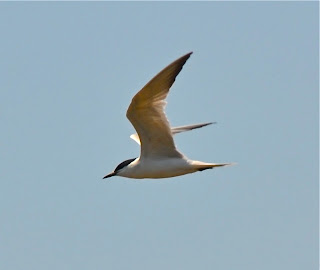Having birded northern California rather thoroughly, it's exciting when I get some lifers up here, because they've become so much harder to come by. So when my buddy Logan Kahle texted me that a Little Bunting had been sighted in McKinleyville, 25 minutes away from Humboldt State University, I knew what my next lifer would be. The only problem was that I had class until 3 o'clock that day, so I had to impatiently wait until then to chase the mega-rarity.
As much as it killed me, I finally finished all my classes, and with another birder friend of mine (another student at HSU named Stephen Montaro), we were off to chase the bird. I've learned that when chasing a bird, one should never expect to see it. As pessimistic as this sounds, too many times have I overconfidently chased a bird, and wound up incredibly disappointed when I didn't see it. If you chase the bird with low expectations, and you miss the bird, you're not disappointed because you anticipated that. However, if you go in with low expectations and you do end up seeing it, the excitement of finding the bird increases tenfold!
So we biked all the way to the Hammond Bridge, the bridge that crosses the Mad River, which was where the bird was seen. The second we crossed the bridge, we saw a horde of people with binoculars and spotting scopes. Call it a hunch, but we figured they were birders. So we joined them, and I even saw a friend from back home, Michael Park, who was just in Humboldt County and only heard of the Little Bunting once he was in Santa Rose (4 hours south), and decided to drive back. We asked if they saw it and one man pointed to his scope, and so I looked through to find myself looking dead-on at, by far, the greatest vagrant I had ever seen. This was the Lower 48's fifth record, California's fourth record, and Humboldt County's very first record. It was an exceptional find made by Keith Slauson, a local birder/biologist that lives just up the road from where he found the bird.
Once I was able to pinpoint exactly where the bird was on the field in front of us, I put my own scope on it and just marveled at the pert sparrow. Little Bunting belongs to the family Emberizidae, along with our local White-crowned Sparrows, for example. In their native range, they breed all throughout Siberia and northern Eurasia, with some breeding populations in Sweden and Norway. They spend their winter in more tropical climes such as southern China or northern India. Reminiscent of our local Savannah Sparrows, this species is identified by its prominent rusty-brown cheek, its white malar stripe, its vague supercilium (more noticeable in breeding plumage), its black stripe reaching behind its eye, its eye-ring, and its white outer tail feathers.
 |
| Humboldt County's first-ever Little Bunting |
 |
| Humboldt County's first-ever Little Bunting |
The tiny little bird caused quite the ruckus. I know people from the Bay Area and from the Sacramento Area that drove up to see this bird. I also met people that flew from Washington state, Florida and even Massachusetts to see this bird!
I saw this bird on the Friday before finals week, so I didn't get to bird a whole ton that weekend. However, all my finals were on Monday, so I got them all done with early in the week. To celebrate, I decided to scour the Arcata Bottoms for any possible vagrants. Unfortunately for me, the birding was pretty slow, and I didn't come across anything major. However, as I was heading back to the dorms, I noticed this large raptor perched atop a telephone pole. I put my binoculars up and saw this was a Ferruginous Hawk! This regal species was long overdue for me, so when I saw this white and orange raptor, I was elated!
 |
| Ferruginous Hawk |
This large raptor is a winter visitor to Humboldt County and is partial to open fields where it can perch atop poles, which serve as perfect vantage points to scope out small mammals to feed on. It earns its name Ferruginous Hawk by its rusty-orangish back, which was absolutely stunning to look at it in the light given by the sunset. It eventually flew off after 20 minutes of looking at it, and I kept on staring at it in awe. It was just a splendid species to see.
The Little Bunting and the Ferruginous Hawk were certainly the highlights of this past week's brief birding. One was a vagrant that attracted a wave of birders from around the country, and the other was a personal victory that I was happy to have seen. Now I can officially say that I am on winter break, and that I will bird the heck out of it!


















































